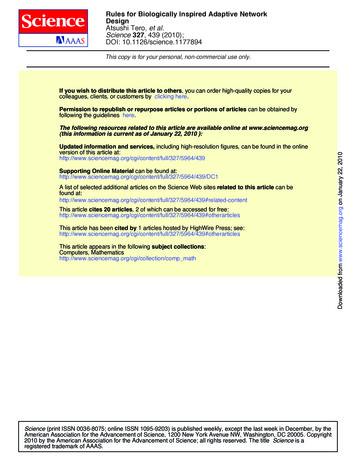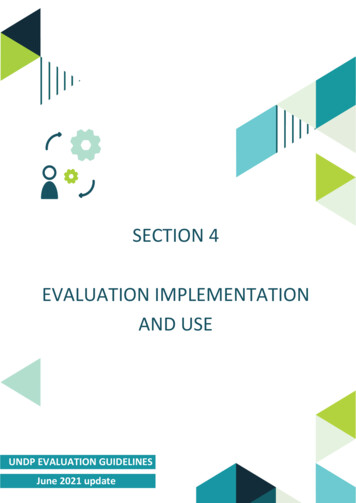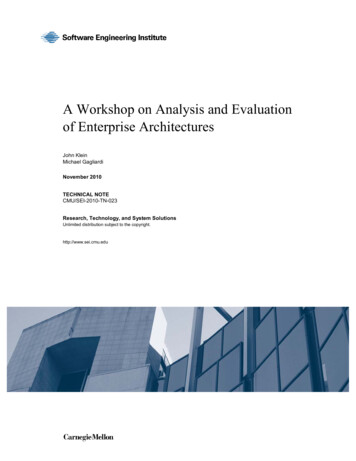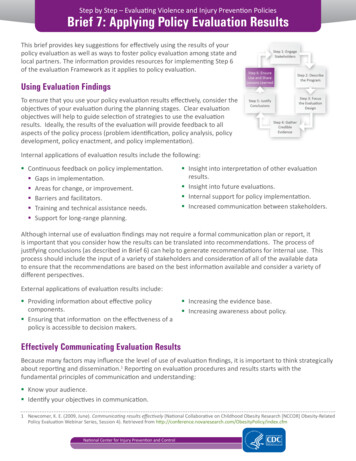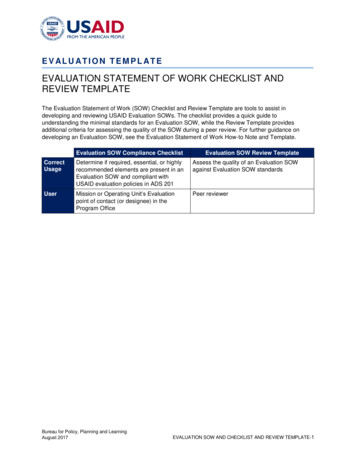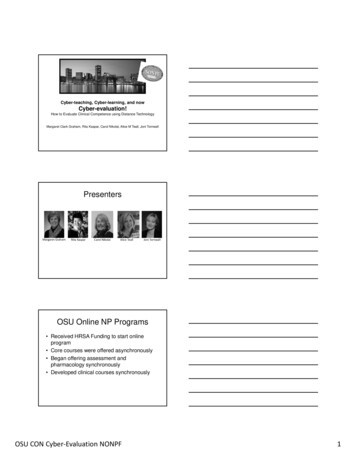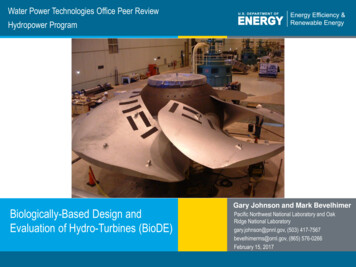
Transcription
Water Power Technologies Office Peer ReviewHydropower ProgramBiologically-Based Design andEvaluation of Hydro-Turbines (BioDE)1 Program Name or Ancillary TextGary Johnson and Mark BevelhimerPacific Northwest National Laboratory and OakRidge National Laboratorygary.johnson@pnnl.gov, (503) 417-7567bevelhimerms@ornl.gov, (865) 576-0266February 15, 2017eere.energy.gov
Project OverviewChallenge: “One of the greatest challenges forhydro remains the understanding andmitigation of impacts to fish” (2014 DOE HydropowerProgram Peer Review).Overall Goal: Influence advanced, fish-friendly turbinedesigns based on biological design criteria derivedfrom scientific, validated predictions of impacts tofish from turbine passageWho Benefits: Hydropower owners and operators,turbine manufacturers, regulatory and resourceagencies, and the fishMain Objectives:1)2)3)Design Tools – Develop, deploy, and support computationalfluid dynamics (CFD) modelling and analysis software(Biological Performance Assessment, BioPA)Evaluation Tools – Deliver and apply Sensor Fish and otherdevices to obtain direct measurements of water and fish(Hydropower Biological Evaluation Tools)Dose-Response – Derive dose-response relationships usinglaboratory experiments that relate mortality of fish to in-turbinestressors (strike, rapid decompression, shear).2 Water Power Technologies Officeeere.energy.gov
Program Strategic PrioritiesNext Generation Hydropower (HydroNEXT)Optimization Optimize technical,environmental, and water-useefficiency of existing fleetGrowth Lower costs of hydropowercomponents and civil works Collect and disseminate data onnew and existing assets Increase power train efficiency forlow-head, variable flowapplications Facilitate interagencycollaboration to increaseregulatory process efficiency Facilitate mechanisms for testingand advancing new hydropowersystems and components Identify revenue streams forancillary services Reduce costs and deploymenttimelines of new PSH plants Prepare the incoming hydropowerworkforce3 Water Power Technologies OfficeSustainability Design new hydropowersystems that minimize or avoidenvironmental impacts Support development of new fishpassage technologies andapproaches Develop technologies, tools,and strategies to evaluate andaddress environmental impacts Increase resilience to climatechangeeere.energy.gov
Program Strategic Priorities: ImpactsSustainabilityDesign new hydropowersystems that minimize oravoid environmental impactsDevelop technologies, tools,and strategies to evaluateand address environmentalimpactsBioPA and Hydropower Biological Evaluation Toolsets4 Water Power Technologies Office ImpactsHigher survival and reduced injury to fishExpanded inference space to many speciesthrough Traits-Based Analysis (TBA)Reduced design and regulatory review timeIncreased sustainable hydropower developmentEndpoint: Routine application of BioDE designand evaluation tools, including state-of-the-artbiological design criteria, to advance sustainablehydropowerTransfer of technologyImproved designs for proposed turbinesField evaluations of new hydro-turbinesFinal Products: Biological PerformanceAssessment (BioPA) and HydropowerBiological Evaluation toolsets (HBET)eere.energy.gov
Technical ApproachDesign ToolsEvaluation ToolsAdvanced CFD models to characterize theenvironment of proposed turbines, i.e.,pressure, shear, and probability of blade strikeand collision.Advanced sensor technology to characterizethe environment of installed turbines, i.e.,pressure, acceleration, rotational velocity.Schematic of sensorfish device showing 3-Dmeasurement frameCFD modeloutput ofstreamlinesthrough aFrancis turbineAnalysis software (BioPA) integrates CFDresults (dose) with lab experiment results(response) to provide a relative index ofbiological performance for different turbinedesigns.Validation of BioPA’s predictions of biologicalperformance (impacts) is an ongoing highpriority.5 Water Power Technologies OfficeComputerizedEvaluationToolsetSensor fish data are also used to validate theCFD model output for the Design Tools.The Sensor Fish and associated applicationstools are termed the Hydropower BiologicalEvaluation toolset.eere.energy.gov
Technical ApproachDose-response Laboratory Experiments – Fish mortality and injury rates are assessedfollowing exposure to simulated turbine stressors of varying magnitude and duration. Resultsare paired with dose measurements from turbine characterizations in BioPA and HBET toolsets.Rapid decompressionSimulated rapid decompression stressor toassess effects of: Rate of pressure change Pressure nadir Species/life stage Total dissolved gas levelsExample doseresponserelationship6 Water Power Technologies OfficeBlade strikeSimulated blade strike stressor to assesseffects of: Blade velocity Blade width Fish size Body location & angle of strike Species/life stageSupporting Tasks Species prioritization Common response metricsShearShearSimulated shear stressor toassess effects of: Water velocity Strain rate Species/life stage Traits-based inference space Population-level interpretation Field studies with Sensor Fisheere.energy.gov
Accomplishments and Progress(FY14–16)Accomplishment**Release of BioPA version 2.0Synthesis of Sensor Fish data on Francis turbines (Fu et al.2016)**Release of the Hydropower Evaluation Toolset version 1.0SignificanceState-of-the-art design tools for the hydropower communityUp-to-date understanding of hydraulic conditions in theFrancis turbine environmentStandard, easy-to-use tools for Sensor Fish study design,signal processing, and biological evaluationCollection of Sensor Fish field measurements for the NatalCharacterization of hydraulic conditions for this new,Turbineinnovative, small hydropower turbinePrioritization of fish species (Pracheil et al. In Press)Analytical process based on regulatory needs to prioritize fishspecies for dose-response experimentsDetermination of a common response metric (mortal injury) for Comparability and integration across various stressor/specieslaboratory experiments (Colotelo et al. 2016)experimental resultsDetermination of the relationship between fish scale type andRefinement and expansion of the Traits Based inferencesusceptibility to descalingspace**Completion of dose-response experiments for strike onExpansion of dose-response relationships to cover newmultiple species, shear on juvenile American shad, and rapidspecies and enhancements for existing speciesdecompression on adult American eelCompletion of a Multi-Year Research Plan (FY16-18)A strategic and tactical framework for implementation of the(PNNL/ORNL 2016a)BioDE**Convening of two Industry Involvement Group meetings,Feedback and lessons learned from the hydropowertwo AFS sessions, and three one-on-one webinarscommunity(PNNL/ORNL 2016b)Formation of a BioDE Scientific Peer Review Group (Cada,Independent, scientific review and input on BioDE researchCarlson, Kirejczyk)priorities, objectives, and methods7 Water Power Technologies Officeeere.energy.gov
Project Plan & ScheduleFY2014Milestone/Deliverable ies prioritizationCommon response metricMulti-Year Research Plan (FY16-18)Synthesis of SF data on Francis turbinesShear-related descaling experimentsStrike experiments (multiple species)Rapid decomp. experiments (adult eel)Shear experiments (juvenile shad)BioPA development and releasesHBET Toolset development and releases8 Water Power Technologies Officev 2.0v 1.0eere.energy.gov
Project Budget and PartnersBudget lPNNLORNLTotal 700K 300K 1,000K 750K 400K 1,150K 1,000K 400K 1,400K Approximately 90% of the three-year project budget has beenexpended to date.This project does not have cost share.Partners, Subcontractors, and Collaborators: PNNL/ORNL collaboration Industry (e.g., Bonneville Power Administration, U.S. Army Corpsof Engineers, Grant Public Utilities District (PUD), Alstom, Andritz,Voith) Resource and regulatory agencies (e.g., Federal EnergyRegulatory Commission, National Marine Fisheries Service, U.S.Fish and Wildlife Service)9 Water Power Technologies Officeeere.energy.gov
Research Integration & CollaborationCommunications and Technology Transfer: Industry Involvement Group (HydroVision) (two sessions)Special sessions and symposia (two sessions)“One-on-one” webinars (three webinars)Talks and posters at conferences (various)Technical reports (three reports)Website (under development)Journal Articles (recent): Colotelo et al. 2016. A comparison of metrics to evaluate the effects of hydro-facility passage stressors on fish.Environmental Reviews. Published online: doi/abs/10.1139/er-2016-0006#.V-p-8fkrIQg. Deng et al. 2016. Evaluation of Boundary Dam Spillway Using an Autonomous Sensor Fish Device, Journal of Hydroenvironment Research doi:dx.doi.org/10.1016/j.jher.2016.10.004 Deng et al. 2016. "Sensor Fish: an autonomous sensor package for characterizing complex flow fields and fishpassage." EWRI Currents 18(3):11. Fu et al. 2016. Assessing hydraulic conditions through Francis turbines using an autonomous sensor device.Renewable Energy 99:1244-1252. Pracheil et al. 2016. A fish-eye view of riverine hydropower systems: understanding the biological response to turbinepassage. Reviews in Fish Biology and Fisheries 26: 153–167. Romero-Gomez and Richmond. 2016. Numerical simulation of circular cylinders in free-fall. Journal of Fluids andStructures 61:154-167. Pracheil et al. (In Press). Traits-based approach for prioritizing species for monitoring and surrogacy selection.Endangered Species Research. Richmond and Romero-Gomez. (In Press). Fish passage though hydropower turbines: simulating blade strike using thediscrete element method. IOP Journal.10 Water Power Technologies Officeeere.energy.gov
Next Steps and Future ResearchFY17/Current research includes advancing the BioPA toolset with cutting edgeCFD technology and new dose-response relationships; performing experimentsfor rapid decompression (prioritized: adult eel) and (prioritized: shear/juvenilestriped bass); validating the BioPA toolset with field data; characterizing hydraulicconditions at hydropower facilities; and continuing outreach and technologytransfer activitiesProposed future research 1) expand biological design criteria to relate resultsto additional priority species through additional dose-response experiments, 2)refine and validate the design tools for accurate predictions, 3) develop modelingtool for rapid assessment of population-level implications, and 4) advance andapply the turbine evaluation technologiesPlans and priorities will be integrated into the BioDE Multi-Year Research Planfor FY18–FY21 with input and review from the BioDE Scientific Peer-ReviewGroup and project partners.Acknowledgments include DOE WPTO, the Corps, Grant County PUD, ElectricPower Research Institute, Bureau of Reclamation, and turbine manufacturers.11 Water Power Technologies Officeeere.energy.gov
biological performance for different turbine designs. Validation of BioPA's predictions of biological performance (impacts) is an ongoing high priority. Evaluation Tools Advanced sensor technology to characterize the environment of installed turbines, i.e., pressure, acceleration, rotational velocity. Sensor fish data are also used to .
